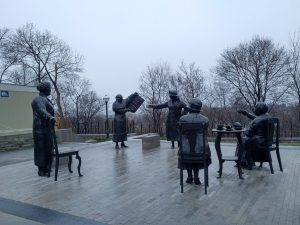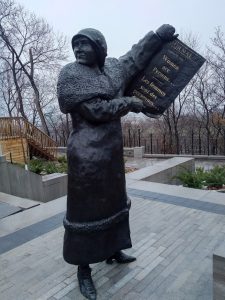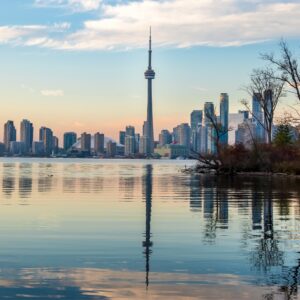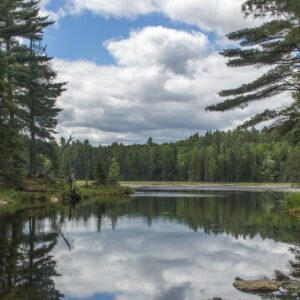Who are the Women for Nature?

Kathy Abusow – Founding Member of Women for Nature

Senator Diane Griffin
This blog is written by Women for Nature member Kathy Abusow, President and CEO of SFI Inc.
The Honourable Diane Griffin, Senator from Prince Edward Island
I was happy to be able to interview my fellow Woman for Nature Diane Griffin in her Senate office. Living in Ottawa means Parliament Hill is something you get used to seeing. But the chance to head inside put me in a reflective mood about politics, power and the role of women.
I started the interview by saying how great it is that the Senate is now one third female and all signs point to the numbers moving to parity in the foreseeable future based on Prime Minister Justin Trudeau’s public commitment to gender equality.
I asked Diane what it was like to get a call from the Prime Minister?
In keeping with his reputation for openness, Diane was impressed how he called her directly. There was no one saying “Please hold for the Prime Minister.” He chatted about the fact that there is a lot of legislation going through and that he wants to get the new senators up and running to move things forward. This description of the prime minister’s pep talk led naturally to my next question.
What inspired you to put your name in the running to become a Senator?

The Famous Five were five Alberta women who asked the Supreme Court of Canada to answer the question, “Does the word ‘Persons’ in the British North America Act, include female persons?” They sought to have women legally considered persons so that women could be appointed to the Senate.
Diane’s passion for nature filled the room as she outlined how she sees being a Senator as a way to advance the causes she has worked her whole life for. Her decades-long commitment to environmental issues saw her become P.E.I.’s Deputy Minister of Environmental Resources and Executive Director of the Island Nature Trust. Diane is also past chair of the boards of Bird Studies Canada, Nature Canada and the Nature Conservancy of Canada (PEI) Inc. and has been on the front lines of countless conservation projects across the province. In addition to her work in P.E.I., Diane served as the Natural Areas Coordinator for the Province of Alberta.
Over the course of her career, she has advised senior political leaders on environmental issues and policy, and has been involved in drafting and enforcing legislation related to ecological reserves conservation and environmental protection. For the past 13 years, Diane served on the Stratford Town Council, where she was a strong voice for balancing environmental sustainability with social and economic sustainability.
How would you describe your basic philosophy on environmental issues?
Diane has two perspectives that are mutually reinforcing. A lot of her career has been spent protecting natural areas with the Nature Conservancy of Canada and the Island Nature Trust. The other half of her experience and interest has been with the wise use of the wider landscape. She makes the important point that it’s no use protecting 10 percent of the landscape and then forgetting about the rest. Diane has always argued that all land has to be well managed but is candid that she hasn’t focused as much on this aspect as on measures to protect natural areas.
When Diane was on the National Round Table on the Environment and the Economy, she worked with industry, academia and conservation groups to look at ways to “move the football down the field” in terms of sustainable development. Diane notes that a lot of people when they hear the words “sustainable development,” some will focus on “sustainable” and some will focus on “development”, the purpose is to focus on both words.
Going forward, she expects this idea of a balanced approach will be front and centre as the discussion around carbon pricing evolves. On a personal note, I was pleased that Diane emphasized the importance of forests in any discussion of climate change and carbon sequestration. This is a huge opportunity for Canada she says. Managing forests sustainably offers an exciting pathway to mitigating some of the effects of climate change.
What inspired you to become a Woman for Nature?
Diane was on the board of Nature Canada and on a subcommittee looking at possible Women for Nature candidates, and a fellow committee member said: “Why don’t you look in the mirror?” Diane saw it as a natural way to extend Nature Canada’s reach and ability to connect people to nature. Diane also relishes the chance to connect with other women who are motivated and have the ability to take action and affect real change. On a specific personal note, Diane says she is looking forward to connecting with Janis Johnson, Women for Nature’s Chair Emeritus, who recently retired from the Senate.

Suffragette Nellie McClung holding a newspaper with the headline “Women are Persons.”
Who were your mentors and what books have inspired you?
Growing up, Diane was mentored by Dr. Ian McQuarrie who was so instrumental in launching the careers of a generation of ecologists that the University of P.E.I. has a graduate scholarship in his name. Urban Laughlin, Diane’s 4H club leader, who instilled in her the value of experiential learning and her uncle, who taught her debating and public speaking skills, were also mentors. Catherine Callbeck was another big influence on Diane. As Premier of P.E.I., she appointed Diane as Deputy Minister of Environmental Resources, and she appointed quite a few women deputy ministers and broke the glass ceiling, which inspired Diane to help other women advance their careers. In a nice twist, Diane is representing P.E.I. as a Senator just like Catherine did until her retirement in 2014.
What advice would you give to future Women for Nature leaders?
Years ago Diane’s advice would have been different than now. At one point, women were in the minority of biologists and ecologists. Today women are the leaders of conservation organizations. But today women still have to work hard to take advantage of opportunities. Technology and the world around us are changing, and Diane says Women for Nature leaders must help other women seize opportunities through mentoring and collaboration.
Diane’s response got me thinking about how things have changed and how we owe a debt to all the women who have fought so hard. I was inspired after the interview to go check out the poignant sculptures of “Women are People” on Parliament Hill. I read the plaque with its story about the female judge and the four women she enlisted to try to bring about change to enable women to be Senators, which would become part of a continent-wide drive for political equality.
Diane is right, we don’t have the same struggles that we had before as women, and we have come a long way, and that’s a great thing, and now it is more about seeing and seizing the opportunities that exist for women to collaborate and bring about positive change. That’s why I am so thrilled with the Women for Nature initiative at Nature Canada.
I’m looking forward to working together to collaborate on important issues that all Canadians can agree on — like getting youth outdoors or maintaining this great nation’s magnificent biodiversity. I’m proud to be a Canadian with a gender-balanced government cabinet and I often refer to this point in the speeches I make regarding the role of women in leadership. I want to thank Diane for her leadership and for inspiring me to visit the statues of those women who made a difference for all of us.
Thanks Diane for your contribution to biodiversity in Canada, a priority for Women in Nature!
To learn more, read this latest opinion piece by Senator Griffin.



